Overcurrent Protection in Power Systems
The thesis explores the proper management of overcurrent protection in power systems through a professional approach.
23 Pages7403 Words41 Views
Added on 2023-01-19
About This Document
This document provides an overview of overcurrent protection in power systems. It explains the importance of overcurrent protection in ensuring personal safety and equipment protection. The document discusses different types of faults and their effects on the system. It also covers the sources of fault current and how to calculate short circuit current. Additionally, the document provides information on the use of fuses in overcurrent protection.
Overcurrent Protection in Power Systems
The thesis explores the proper management of overcurrent protection in power systems through a professional approach.
Added on 2023-01-19
ShareRelated Documents
OVERCURRENT PROTECTION IN POWER SYSTEMS
Introduction
When an equipment (e.g. transmission line, transformer, generator, motor) is
operating within the rated
specifications (speed, voltage, current etc.), we say that it is in the normal
state. Therefore, abnormal
state pertains to deviation from the rated operating point. It may refer to
overcurrent, under voltage, over or under frequency. If the apparatus
continues to operate in this state for long enough time, it can lead to
damage or reduction in life of the equipment. On the other hand, it may be
also unsafe to operate in this region. A fault refers to a serious abnormality
which typically requires immediate de-energization of the equipment.
Usually, faults are considered dangerous because of overcurrent that they
create. This can damage the
apparatus and it endangers the human safety. Three phase faults, Line to
Line faults (LL), Single Line to
Ground fault (SLG), Line to Line Ground faults (LLG) are some standard faults
considered in our analysis.
Three phase faults and Line to Line faults are also known as phase faults
while Single Line to Ground and
Double Line to Ground faults are also known as ground faults. However, not
all faults create large
overcurrents. For example, earth faults which may result due to partial
insulation failure may not create
large currents. However, it makes operation of the equipment unsafe from
human safety perspective and further, if the fault is left unattended it can
aggravate.
Typically, power system protection, refers to fault detection and
deenergization of the equipment. In contrast, condition monitoring refers to
monitoring the equipment to detect possibility of equipment failure.
Condition monitoring and good maintenance can reduce a number of
potential faults.
Introduction
When an equipment (e.g. transmission line, transformer, generator, motor) is
operating within the rated
specifications (speed, voltage, current etc.), we say that it is in the normal
state. Therefore, abnormal
state pertains to deviation from the rated operating point. It may refer to
overcurrent, under voltage, over or under frequency. If the apparatus
continues to operate in this state for long enough time, it can lead to
damage or reduction in life of the equipment. On the other hand, it may be
also unsafe to operate in this region. A fault refers to a serious abnormality
which typically requires immediate de-energization of the equipment.
Usually, faults are considered dangerous because of overcurrent that they
create. This can damage the
apparatus and it endangers the human safety. Three phase faults, Line to
Line faults (LL), Single Line to
Ground fault (SLG), Line to Line Ground faults (LLG) are some standard faults
considered in our analysis.
Three phase faults and Line to Line faults are also known as phase faults
while Single Line to Ground and
Double Line to Ground faults are also known as ground faults. However, not
all faults create large
overcurrents. For example, earth faults which may result due to partial
insulation failure may not create
large currents. However, it makes operation of the equipment unsafe from
human safety perspective and further, if the fault is left unattended it can
aggravate.
Typically, power system protection, refers to fault detection and
deenergization of the equipment. In contrast, condition monitoring refers to
monitoring the equipment to detect possibility of equipment failure.
Condition monitoring and good maintenance can reduce a number of
potential faults.
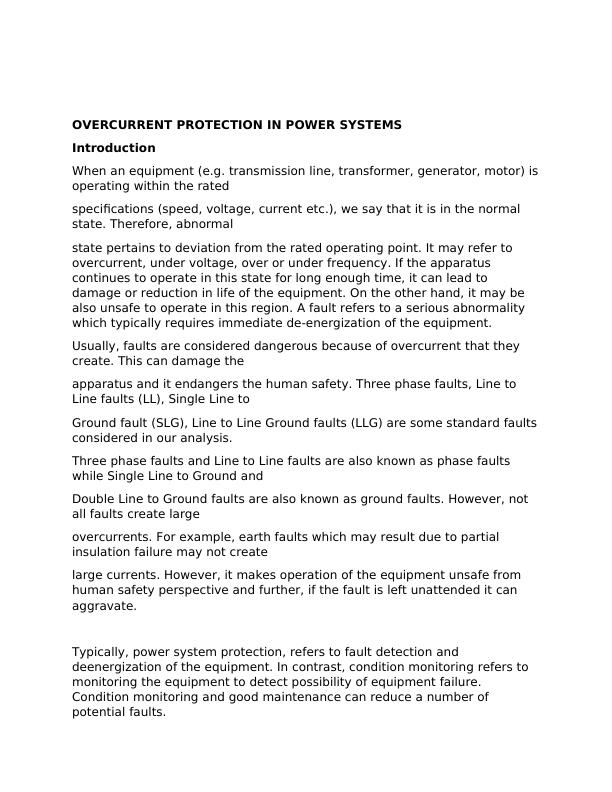
Overcurrent protection is critical to personal safety and protection from a
number of hazardous conditions that can result from materials igniting due
to improper overload protection or short-circuit protection. Additionally, the
OCPD guards against explosive ignition and flash hazards from inadequate
voltage-rated or improper interrupting-rated overcurrent protective devices.
Overcurrent protective devices, or OCPDs, are typically used in main service
disconnects, and in the feeders and branch circuits of electrical systems for
residential, commercial, institutional, and industrial premises.
Overcurrent protection devices are meant to protect against the potentially
dangerous effects of overcurrents, such as an overload current or a short-
circuit current, which creates a fault current. Equipment damage, personal
injury, and even death can result from the improper application of a device's
voltage rating, current rating, or interrupting rating. Something as simple as
a circuit breaker can protect against this damage, but if a fuse or circuit
breaker doesn't have an adequate voltage rating, it can rupture or explode
while attempting to stop fault currents beyond their interrupting ratings.
Grounding helps to protect against inadequate overcurrent protection or
OCPD failure. The two processes are designed to work together to protect
equipment, property, and people.
Literature Review
This chapter presents the review of various concepts and techniques that
were used in Overcurrent & Earth fault relays, integrated protective relays &
metering and Networking of protection relays in substations
Overcurrent and Earth fault relays Benmouyal et al (1999) described IEEE
standard inverse characteristic equations for overcurrent relays. This paper
introduces the new standard “IEEE standard inverse relays”. It provides an
analytic repres relays operating characteristic curve shapes in order to
facilitate coordination when using microprocessor Sutherland (1999)
presented Application of transformer ground differential protection relays. Tr
relays (device 87G) have been used to protect the windings of resistance
grounded transformers. A number of strategies have been utilized with
electromechanical relays digital protective relay of protection. CHAPTER 2
number of hazardous conditions that can result from materials igniting due
to improper overload protection or short-circuit protection. Additionally, the
OCPD guards against explosive ignition and flash hazards from inadequate
voltage-rated or improper interrupting-rated overcurrent protective devices.
Overcurrent protective devices, or OCPDs, are typically used in main service
disconnects, and in the feeders and branch circuits of electrical systems for
residential, commercial, institutional, and industrial premises.
Overcurrent protection devices are meant to protect against the potentially
dangerous effects of overcurrents, such as an overload current or a short-
circuit current, which creates a fault current. Equipment damage, personal
injury, and even death can result from the improper application of a device's
voltage rating, current rating, or interrupting rating. Something as simple as
a circuit breaker can protect against this damage, but if a fuse or circuit
breaker doesn't have an adequate voltage rating, it can rupture or explode
while attempting to stop fault currents beyond their interrupting ratings.
Grounding helps to protect against inadequate overcurrent protection or
OCPD failure. The two processes are designed to work together to protect
equipment, property, and people.
Literature Review
This chapter presents the review of various concepts and techniques that
were used in Overcurrent & Earth fault relays, integrated protective relays &
metering and Networking of protection relays in substations
Overcurrent and Earth fault relays Benmouyal et al (1999) described IEEE
standard inverse characteristic equations for overcurrent relays. This paper
introduces the new standard “IEEE standard inverse relays”. It provides an
analytic repres relays operating characteristic curve shapes in order to
facilitate coordination when using microprocessor Sutherland (1999)
presented Application of transformer ground differential protection relays. Tr
relays (device 87G) have been used to protect the windings of resistance
grounded transformers. A number of strategies have been utilized with
electromechanical relays digital protective relay of protection. CHAPTER 2
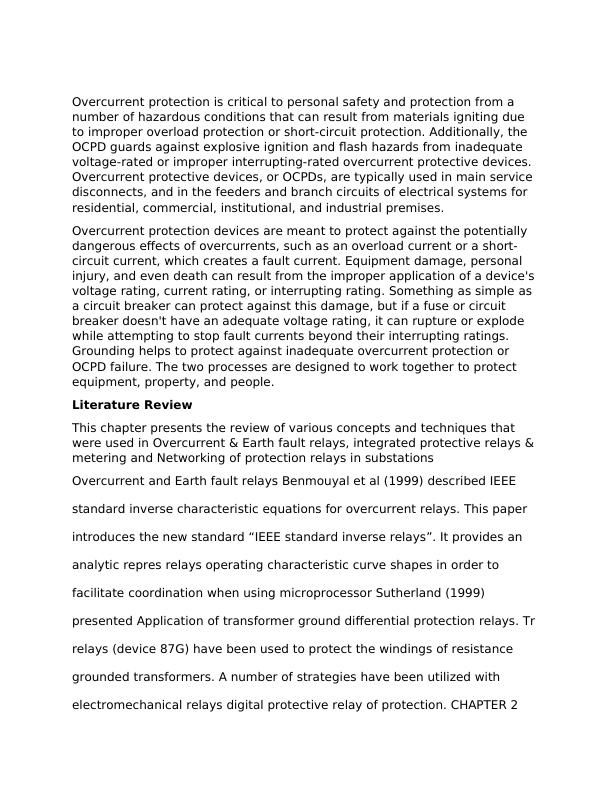
LITERATURE REVIEW INTRODUCTION This chapter presents the review of
various concepts and techniques were used in Overcurrent & Earth fault
relays, integrated protective relays & metering and Networking of protection
relays in substations. Overcurrent and Earth fault relays Benmouyal et al
(1999) described IEEE standard inverse characteristic equations for
overcurrent relays. This paper introduces the new standard “IEEE standard
inverse-time characteristic equations for overcurrent relays”. It provides an
analytic representation of typical electromechanical relays operating
characteristic curve shapes in order to facilitate coordination when using
microprocessor-type relays. Sutherland (1999) presented Application of
transformer ground differential protection relays. Transformer ground
differential protection (device 87G) have been used to protect the windings
of resistance grounded transformers. A number of strategies have been
utilized with relays in the past. With the advent of the multifuncti relay, these
strategies can be adapted to continue this form 13 This chapter presents the
review of various concepts and techniques were used in Overcurrent & Earth
fault relays, integrated protective relays & metering and Networking of
protection relays in substations. Benmouyal et al (1999) described IEEE
standard inverse-time characteristic equations for overcurrent relays. This
paper introduces the new time characteristic equations for overcurrent
entation of typical electromechanical relays operating characteristic curve
shapes in order to facilitate coordination Sutherland (1999) presented
Application of transformer ground ansformer ground differential protection
various concepts and techniques were used in Overcurrent & Earth fault
relays, integrated protective relays & metering and Networking of protection
relays in substations. Overcurrent and Earth fault relays Benmouyal et al
(1999) described IEEE standard inverse characteristic equations for
overcurrent relays. This paper introduces the new standard “IEEE standard
inverse-time characteristic equations for overcurrent relays”. It provides an
analytic representation of typical electromechanical relays operating
characteristic curve shapes in order to facilitate coordination when using
microprocessor-type relays. Sutherland (1999) presented Application of
transformer ground differential protection relays. Transformer ground
differential protection (device 87G) have been used to protect the windings
of resistance grounded transformers. A number of strategies have been
utilized with relays in the past. With the advent of the multifuncti relay, these
strategies can be adapted to continue this form 13 This chapter presents the
review of various concepts and techniques were used in Overcurrent & Earth
fault relays, integrated protective relays & metering and Networking of
protection relays in substations. Benmouyal et al (1999) described IEEE
standard inverse-time characteristic equations for overcurrent relays. This
paper introduces the new time characteristic equations for overcurrent
entation of typical electromechanical relays operating characteristic curve
shapes in order to facilitate coordination Sutherland (1999) presented
Application of transformer ground ansformer ground differential protection
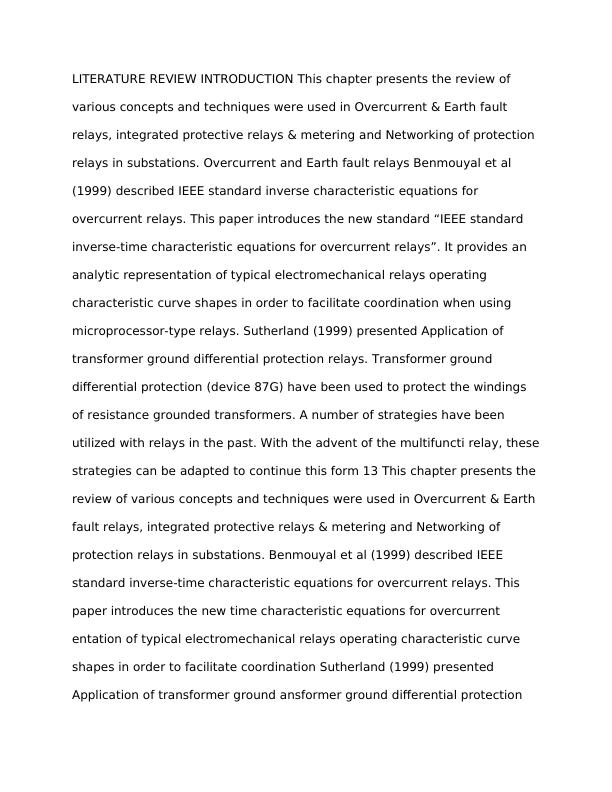
(device 87G) have been used to protect the windings of resistance grounded
transformers. A number of strategies have been utilized with in the past.
With the advent of the multifunction , these strategies can be adapted to
continue this form Wang et al (2001) designed the Multifunctional Numerical
Transformer Protection and Control System with Adaptive and Flexible
Features. The numerical transfo in this paper is a powerful, multifunctional,
adaptive, flexible system which provides a lot of possibilities for different
applications in transformer protections and similar applications are as such
as shunt r generator protections, etc. The advanced features in this new
system show a further step in the development of modern numerical
protection and control systems with improved protection functionality and
almost unlimited flexibility for solving most application cases. Darwish et al
(2001) have presented the design of A Novel Overcurrent Relay with
universal characteristics based on relay characteristic modelling. The relay
algorithms have been implemented using Digital Signal Processor (DSP) on a
real time basis and simulated in computer only for overcurrent protection.
The designed relay has the flexibility in selecting the appropriate
characteristic for the system requirement. This numerical relay offers only
the overcurrent function. Ito et al (2001) presented the Multifunction High
Speed Operating Current Differential Relay for Transmission Line differential
relay as a transmission line unit protection was launch Toshiba. High speed
operation was achieved by communicating the instantaneous values of the
three phase currents, sampled at 600Hz in a 50Hz system. Watanabe et al
transformers. A number of strategies have been utilized with in the past.
With the advent of the multifunction , these strategies can be adapted to
continue this form Wang et al (2001) designed the Multifunctional Numerical
Transformer Protection and Control System with Adaptive and Flexible
Features. The numerical transfo in this paper is a powerful, multifunctional,
adaptive, flexible system which provides a lot of possibilities for different
applications in transformer protections and similar applications are as such
as shunt r generator protections, etc. The advanced features in this new
system show a further step in the development of modern numerical
protection and control systems with improved protection functionality and
almost unlimited flexibility for solving most application cases. Darwish et al
(2001) have presented the design of A Novel Overcurrent Relay with
universal characteristics based on relay characteristic modelling. The relay
algorithms have been implemented using Digital Signal Processor (DSP) on a
real time basis and simulated in computer only for overcurrent protection.
The designed relay has the flexibility in selecting the appropriate
characteristic for the system requirement. This numerical relay offers only
the overcurrent function. Ito et al (2001) presented the Multifunction High
Speed Operating Current Differential Relay for Transmission Line differential
relay as a transmission line unit protection was launch Toshiba. High speed
operation was achieved by communicating the instantaneous values of the
three phase currents, sampled at 600Hz in a 50Hz system. Watanabe et al
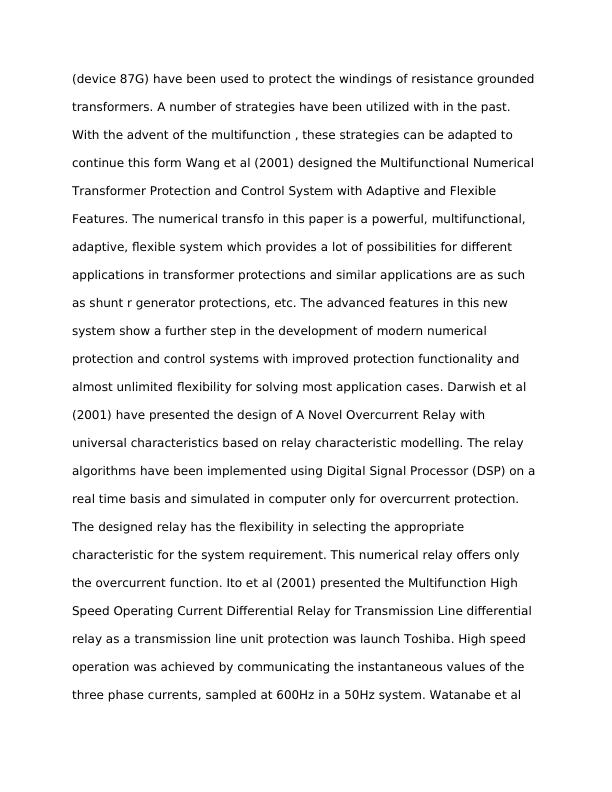
(2001) designed an enhanced decentralized numerical bus bar protection
relay utilizing high speed sampling. Advancement in numerical and
communication Wang et al (2001) designed the Multifunctional Numerical
Transformer Protection and Control System with Adaptive and Flexible
Features. The numerical transformer protection and control system
described in this paper is a powerful, multifunctional, adaptive, flexible
system which provides a lot of possibilities for different applications in
transformer protections and similar applications are as such as shunt reactor
protections, generator protections, etc. The advanced features in this new
system show a further step in the development of modern numerical
protection and control systems with improved protection functionality and
almost unlimited olving most application cases. Darwish et al (2001) have
presented the design of A Novel Overcurrent Relay with universal
characteristics based on relay characteristic modelling. The relay algorithms
have been implemented using Digital Signal SP) on a real time basis and
simulated in computer only for overcurrent protection. The designed relay
has the flexibility in selecting the appropriate characteristic for the system
requirement. This numerical relay offers only the overcurrent function. to et
al (2001) presented the Development of an Improved Multifunction High
Speed Operating Current Differential Relay for Line Protection. Numerical
phase-segregated current differential relay as a transmission line unit
protection was launch Toshiba. High speed operation was achieved by
communicating the instantaneous values of the three phase currents,
relay utilizing high speed sampling. Advancement in numerical and
communication Wang et al (2001) designed the Multifunctional Numerical
Transformer Protection and Control System with Adaptive and Flexible
Features. The numerical transformer protection and control system
described in this paper is a powerful, multifunctional, adaptive, flexible
system which provides a lot of possibilities for different applications in
transformer protections and similar applications are as such as shunt reactor
protections, generator protections, etc. The advanced features in this new
system show a further step in the development of modern numerical
protection and control systems with improved protection functionality and
almost unlimited olving most application cases. Darwish et al (2001) have
presented the design of A Novel Overcurrent Relay with universal
characteristics based on relay characteristic modelling. The relay algorithms
have been implemented using Digital Signal SP) on a real time basis and
simulated in computer only for overcurrent protection. The designed relay
has the flexibility in selecting the appropriate characteristic for the system
requirement. This numerical relay offers only the overcurrent function. to et
al (2001) presented the Development of an Improved Multifunction High
Speed Operating Current Differential Relay for Line Protection. Numerical
phase-segregated current differential relay as a transmission line unit
protection was launch Toshiba. High speed operation was achieved by
communicating the instantaneous values of the three phase currents,

sampled at 600Hz in a 50Hz Watanabe et al (2001) designed an enhanced
decentralised numerical busbar protection relay utilizing instantaneous
current values from high speed sampling. Advancement in numerical and
communication 14 Wang et al (2001) designed the Multifunctional Numerical
Transformer Protection and Control System with Adaptive and Flexible rmer
protection and control system described in this paper is a powerful,
multifunctional, adaptive, flexible system which provides a lot of possibilities
for different applications in transformer eactor protections, generator
protections, etc. The advanced features in this new system show a further
step in the development of modern numerical protection and control systems
with improved protection functionality and almost unlimited Darwish et al
(2001) have presented the design of A Novel Overcurrent Relay with
universal characteristics based on relay characteristic modelling. The relay
algorithms have been implemented using Digital Signal SP) on a real time
basis and simulated in computer only for overcurrent protection. The
designed relay has the flexibility in selecting the appropriate characteristic
for the system requirement. This numerical relay Development of an
Improved Multifunction High Speed Operating Current Differential Relay for
segregated current differential relay as a transmission line unit protection
was launched by Toshiba. High speed operation was achieved by
communicating the instantaneous values of the three phase currents,
sampled at 600Hz in a 50Hz Watanabe et al (2001) designed an enhanced
decentralised instantaneous current values from high speed sampling.
decentralised numerical busbar protection relay utilizing instantaneous
current values from high speed sampling. Advancement in numerical and
communication 14 Wang et al (2001) designed the Multifunctional Numerical
Transformer Protection and Control System with Adaptive and Flexible rmer
protection and control system described in this paper is a powerful,
multifunctional, adaptive, flexible system which provides a lot of possibilities
for different applications in transformer eactor protections, generator
protections, etc. The advanced features in this new system show a further
step in the development of modern numerical protection and control systems
with improved protection functionality and almost unlimited Darwish et al
(2001) have presented the design of A Novel Overcurrent Relay with
universal characteristics based on relay characteristic modelling. The relay
algorithms have been implemented using Digital Signal SP) on a real time
basis and simulated in computer only for overcurrent protection. The
designed relay has the flexibility in selecting the appropriate characteristic
for the system requirement. This numerical relay Development of an
Improved Multifunction High Speed Operating Current Differential Relay for
segregated current differential relay as a transmission line unit protection
was launched by Toshiba. High speed operation was achieved by
communicating the instantaneous values of the three phase currents,
sampled at 600Hz in a 50Hz Watanabe et al (2001) designed an enhanced
decentralised instantaneous current values from high speed sampling.
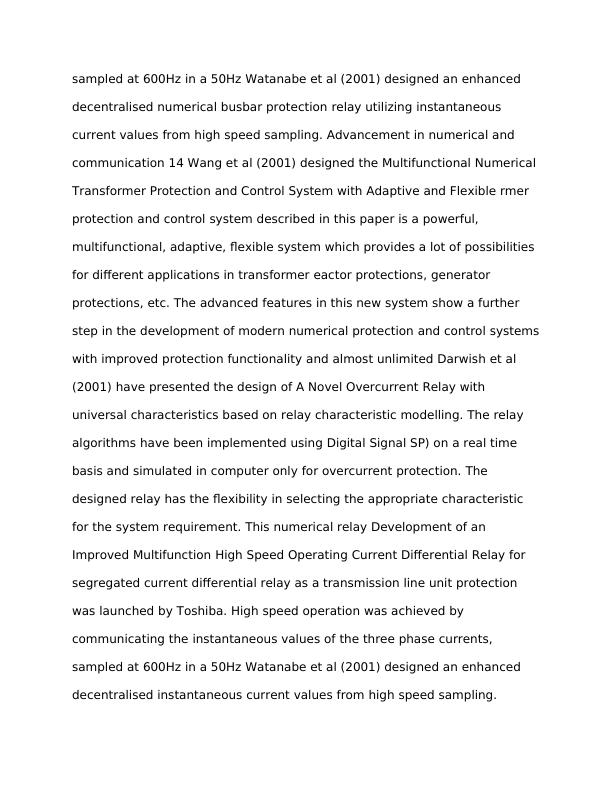
End of preview
Want to access all the pages? Upload your documents or become a member.
Related Documents
Effective use of Safety Monitoring Equipment - Assignmentlg...
|6
|964
|242
Power is directly proportionallg...
|9
|1632
|19
Power Protection System: Principles, Design, and Operationlg...
|9
|1442
|314
Diploma in Electrical Installation: Circuit Diagram, Luminaires, Circuit Protection Devices, Design Current, CPC, Isolation and Switchinglg...
|7
|1048
|451
Electric Circuits Assignment - Deskliblg...
|7
|916
|120
Manage Health & Safety in Construction Workplace - Deskliblg...
|19
|3588
|421
